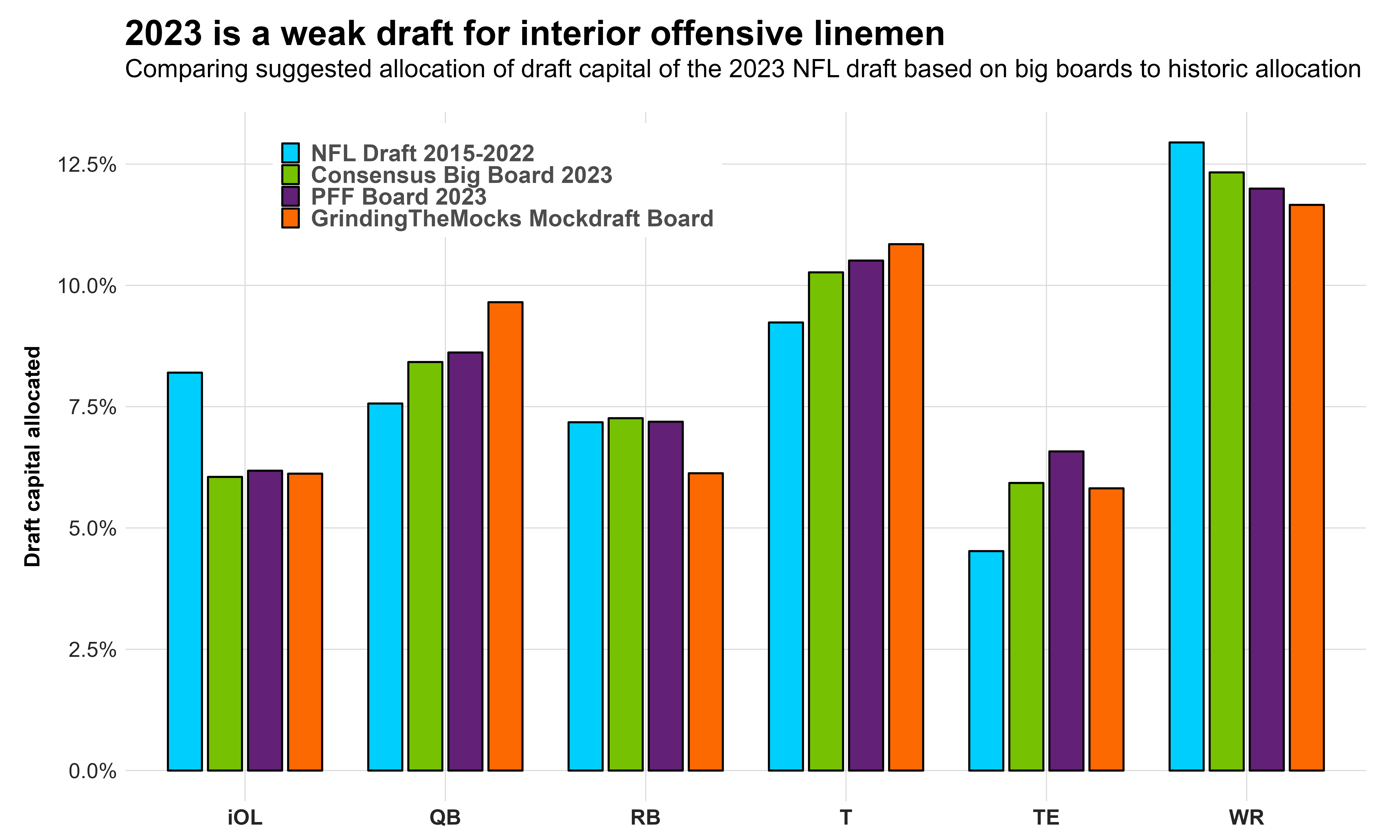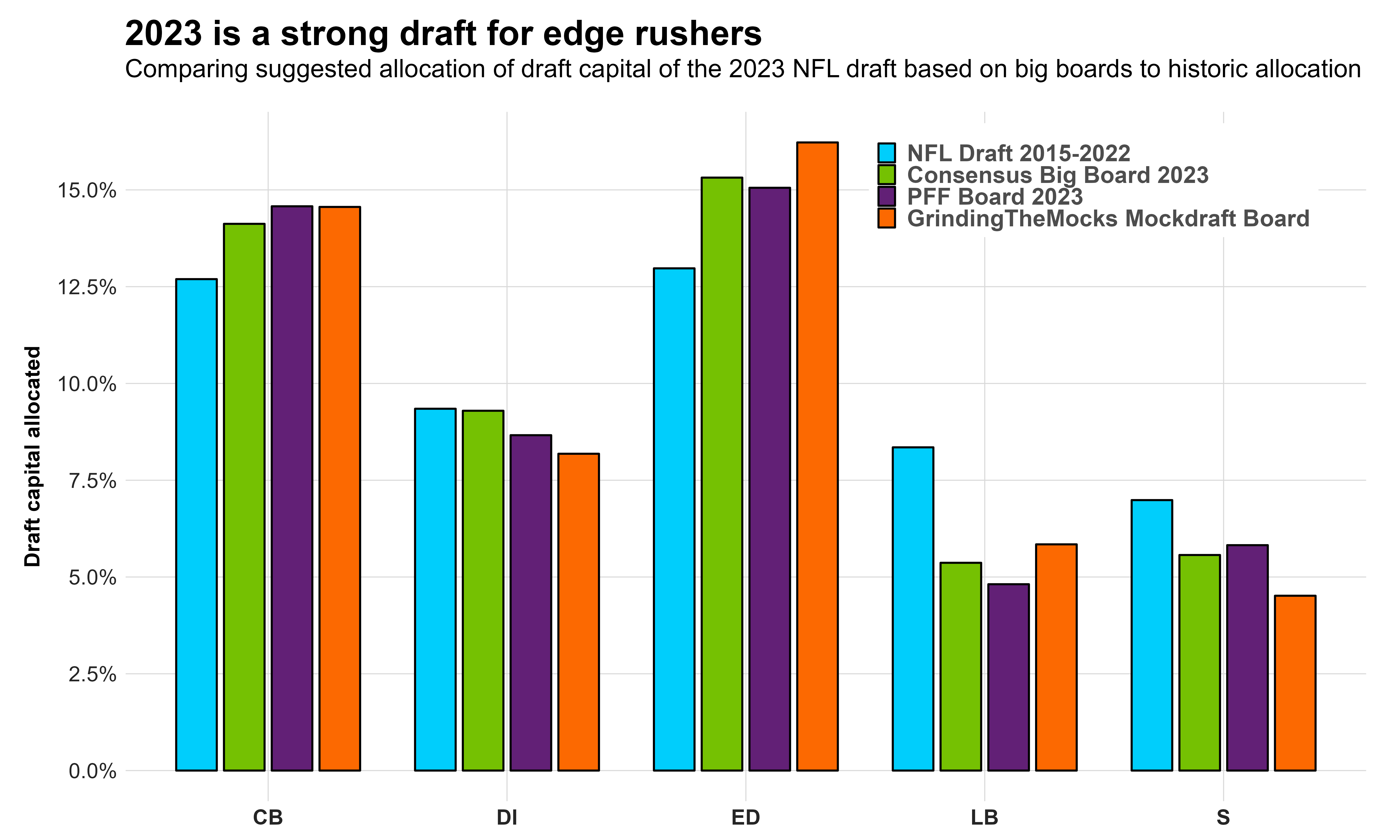• The 2023 quarterback class is fairly strong: There is a quarterback worthy of the first overall pick and several other quarterbacks who possess top-10 and even top-five talent.
• Not much promise at linebacker: This year’s class might be completely devoid of first-round talent — Iowa's Jack Campbell and Arkansas' Drew Sanders are currently the only linebackers projected to be fringe first-round picks.
• All eyes on edge defender: We currently have 14 edge rushers in the top 64 of our big board. Over the previous eight drafts, the record for most edge defenders taken in the first two rounds is 12.
Estimated reading time: 8 minutes
Earlier this offseason, we took an initial look at the talent available at each position in this year’s draft class, and we revisited it after the NFL scouting combine. Now, with the 2023 NFL Draft less than eight hours away, it’s time for one last look.
Once again, we are partnering with Benjamin Robinson‘s GrindingTheMocks.com to use consensus mock draft data to learn more about this year’s prospects. This data not only helps us investigate the talent at each position but also fuels the computer-simulated picks for PFF's mock draft simulator. We are also using Arif Hasan's Industry Consensus Big Board, which amalgamates the draft rankings of 70 analysts into one big board and has proven to be fairly accurate when predicting the NFL draft.
More PFF draft content:
LIVE Draft Tracker | Mock Draft Simulator | 2023 NFL Draft Guide
Top 200 Big Board | PFF Mock Drafts | Measureables & Workout Data
NCAA Premium Stats | Draft Rankings By Position | Prospect Superlatives
Overview of positional strength
We measure the strength of each position in a given draft class by the draft capital allocated to the position. To quantify draft capital, we use the PFF WAR draft chart. You can find a more detailed explanation in last year’s version of this article.
We then compare the draft capital allocated to each position over the last eight drafts to the capital projected to be allocated to each position in 2023.
The allocation may change come draft time, but it's currently the natural way to measure each position's strength in a way comparable to the actual drafts from past years.
Here is the overview of offensive positions.

The last three drafts have been record-breaking in terms of the number of highly drafted wide receivers, and most of those pass-catchers haven’t disappointed in the NFL.
This year might be different, as we are currently looking at a class with only five or six top-50 prospects, in stark contrast to a 2022 class that produced six wide receivers who were drafted within the first 18 picks.
Another position group that looks much bleaker than last year is interior offensive line. The 2022 draft featured three consensus blue-chip first-round talents in Tyler Linderbaum, Kenyon Green and Zion Johnson. This year, O’Cyrus Torrence is currently the only borderline first-round talent.
We proceed with the overview of the defensive positions:

The edge defenders stand out on this chart, which is unsurprising, given that our big board currently features 13 edge rushers in the top 50 and seven in the top 32.
On the other end of the spectrum, linebacker shapes up to be a fairly weak position in this year’s draft, as it might be completely devoid of first-round talent — Iowa's Jack Campbell and Arkansas' Drew Sanders are currently the only linebackers who are projected to be fringe first-round picks.
A deeper look can help make draft decisions
The overview is definitely nice to have, but when a team has the 25th overall pick, they need to have a concrete idea of whether a certain position is strong because there is a lot of top-15 talent and a deep Day 2 or whether the position is strong because of several late first-round prospects who would most likely be available when the team is on the clock.
For that reason, we have created charts that show the available talent at each position at each point in the draft. The charts compare that talent to the ceiling, floor and average of the last eight drafts.
We start with the most important position — quarterback.

For example, the maximum number of quarterbacks taken with the first 15 picks is five, which occurred two years ago with Trevor Lawrence, Zach Wilson, Trey Lance, Justin Fields and Mac Jones all coming off the board early.
The minimum number of quarterbacks taken in the first two rounds (first 64 picks) is two, as only Jameis Winston and Marcus Mariota came off the board early in 2015.
On average, there have been between three and four quarterback selections in the first round.
Basically, the three lines give us a mean expectation and a range for how many players at a given position are taken through X selections. The points show us the number of players at the position through rank X of the 2023 big board.
The yellow squares describe the QB's ranking on the PFF draft board, the purple diamonds describe the ranking on the GrindingTheMocks Consensus Big Board and the teal triangles describe the ranking on the Industry Consensus Big Board. We will use the same colors and shapes for all the other positions.
Loosely speaking, we can spot a weak class by looking at points below the average line, and we can spot a strong class by points above the average line.
This means we have a fairly strong quarterback class this year, with a quarterback worthy of the first overall pick and several other quarterbacks with top-10 and even top-five talent. However, we can also see that there is very little Day 2 talent, so finding the next Jalen Hurts could prove to be difficult.
Potentially elite: ED, TE, OT and CB
We continue with edge rusher, which is looking like one of the best classes in recent years.

We currently have 13 edge rushers in the top 64 of the GrindingTheMock mock draft date. Over the previous eight drafts, the record for most edge defenders taken in the first two rounds is 12.
On average, a tight end is a position that sees only five prospects come off the board within the first two days of the draft. This year shapes up to be a bit stronger because we have three fringe first-round talents, just as we did in 2017.
Additionally, we could see up to six or seven tight ends drafted in the first three rounds, which is more than usual.

Free for 7-days. Subscribe to continue reading and unlock
 All premium content with the best insights + analysis in the game
All premium content with the best insights + analysis in the game
 NFL Draft Guide, Big Board + Mock Draft Sim
NFL Draft Guide, Big Board + Mock Draft Sim
 Fantasy Draft Kit and Nathan Jahnke's award winning rankings
Fantasy Draft Kit and Nathan Jahnke's award winning rankings
 Bet smarter with PFF player mismatches and expert betting insights
Bet smarter with PFF player mismatches and expert betting insights
 NFL and CFB player grades and premium stats
NFL and CFB player grades and premium stats
 Unlock all PFF data trusted by all 32 NFL teams
Unlock all PFF data trusted by all 32 NFL teams
Already have a subscription? Log In



 © 2023 PFF - all rights reserved.
© 2023 PFF - all rights reserved.